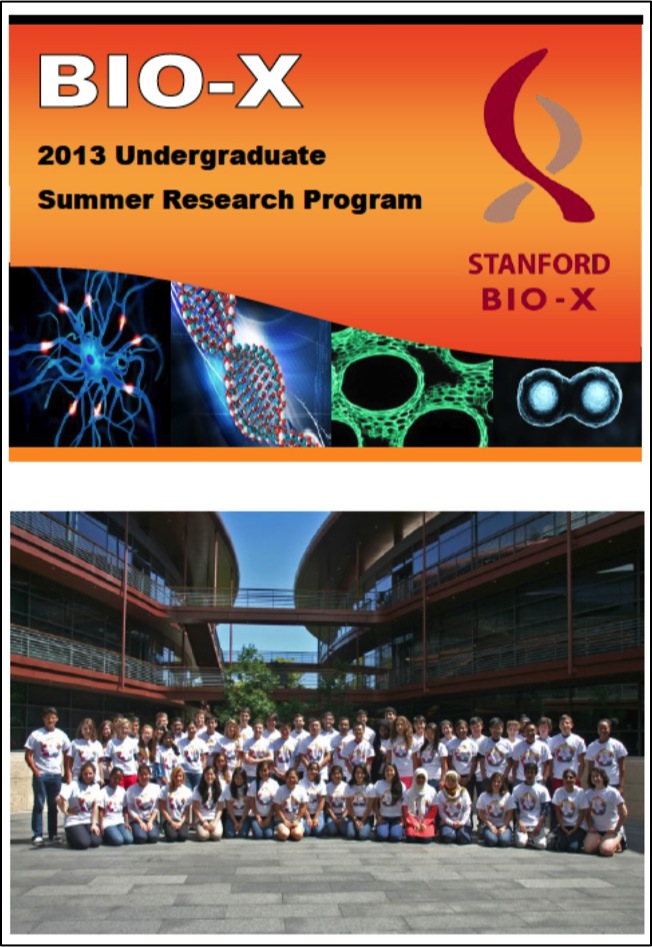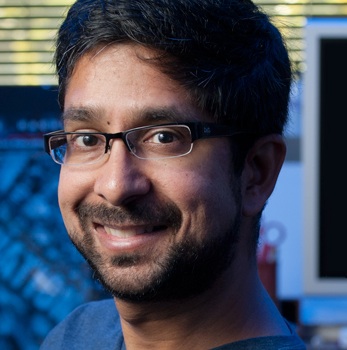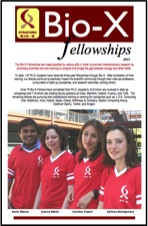
Welcome to the biweekly electronic newsletter from Stanford Bio-X for members of the Bio-X Corporate Forum. Please contact us if you would like to be added or removed from this distribution list, or if you have any questions about Stanford Bio-X or Stanford University.
Highlights
** On October 9, 2013, Bio-X celebrated the 10th Anniversary of the James H. Clark Center, the hub of Bio-X. Check out CLARK CENTER @ 10X on the SPLASH PAGE as well as the Bio-X Timeline over the last 15 years!!
** Check out the article by Stanford President John Hennessy in the Nov/Dec 2013 issue of the Stanford Magazine on Bio-X and the Clark Center, "A Cauldron of Innovation".
Seed Grants
 SEED GRANTS FOR SUCCESS - Stanford Bio-X Interdisciplinary Initiatives Program (IIP)
SEED GRANTS FOR SUCCESS - Stanford Bio-X Interdisciplinary Initiatives Program (IIP)
The Bio-X Interdisciplinary Initiatives Program represents a key Stanford Initiative to address challenges in human health. The IIP awards approximately $3 million every other year in the form of two-year grants averaging about $150,000 each. From its inception in 2000 through the fifth round in 2010, the program has provided critical early-stage funding to 114 different interdisciplinary projects, involving collaborations from over 300 faculty members, and creating over 450 teams from five different Stanford schools. From just the first 5 rounds, the IIP awards have resulted in a 10-fold-plus return on investment, as well as hundreds of publications, dozens of patents filed, and most importantly, the acceleration of scientific discovery and innovation.
In 2012, Stanford Bio-X selected 23 new seed grant projects as the winners of the 6th round. Please go here to view the list of awardees, along with the titles of their projects and the abstracts of the research. Competition was intense as the awardees were chosen from 118 Letters of Intent (LOIs). Selection criteria included innovation, high-reward, and interdisciplinary collaboration. (To view the 114 other IIP projects that have been funded from the first 5 rounds, please click here.) In addition, SANOFI has also funded 4 new Bio-X IIP Seed Grant projects from round 6!
On Monday, August 26, 2013, Bio-X had its second annual IIP Symposium of the year at the Clark Center, which highlights projects that exemplify the Stanford Bio-X mission of crossing boundaries to bring about interdisciplinary research and solutions in the field of life bioscience. The symposium was a huge success with over 300 people attending this event, which included 8 oral presentations and 136 poster presentations. Recorded talks from the symposium will be uploaded soon. If you'd like to view the talks for previous symposia through the years, please click here.
We are cultivating and are highly successful in building meaningful collaborations with numerous corporate colleagues. New collaborations through our seed grant projects are highly encouraged. To learn about how to get involved, please contact Dr. Hanwei Li or Dr. Heideh Fattaey.
Fellowships
Every year, graduate students and postdoctoral scholars of Bio-X affiliated faculty are highly encouraged to apply for the Bio-X Fellowships, which are awarded to research projects that are interdisciplinary and utilize the technologies of different fields to solve different biological questions. Students are encouraged to work collaboratively with professors of different departments, thus creating cross-disciplinary relationships among the different Stanford schools. Our fellows have conducted exciting research, resulting in publications in high-impact journals and have been offered excellent positions in industry and academia. To date, Stanford Bio-X has a total of 152 Fellows.
On June 26th, Bio-X held its annual Bio-X Fellows Symposium, where there were four 15-minute oral presentations followed by one-minute spiels from current fellows. The 25 newest fellows selected this year were also announced, and about 100 attendees came to the symposium. Please click on the "Bio-X Fellows Symposium" link above for the agenda and titles of the talks, and on the icon of the brochure above for the updated and latest Bio-X Fellowships brochure.
To view the numerous projects that have been awarded over the years, please click here.
 BIO-X UNDERGRADUATE SUMMER RESEARCH PROGRAM
BIO-X UNDERGRADUATE SUMMER RESEARCH PROGRAM
The Bio-X Undergraduate Summer Research Program supports undergraduate research training through an award designed to support interdisciplinary undergraduate summer research projects. The program is an invaluable opportunity for students to conduct hands-on research, learn how to carry out experiments in the laboratory, and develop the skills to read and analyze scientific literature.
This program is eligible to Stanford students who want to work in the labs of Bio-X affiliated faculty. To date, 241 students have been awarded the opportunity to participate in the Bio-X Undergraduate Summer Research Program. This summer is Stanford Bio-X's 8th round of USRP.
Participating undergraduates are also required to present poster presentations on the research that they've conducted during the program. Please click here for title lists of past posters that our undergraduates have presented.
Many fruitful collaborations and relationships have been established with industry through fellowships. Please contact Dr. Hanwei Li or Dr. Heideh Fattaey if you'd like to learn more about how to get involved with these fellowship programs.
News
 Stanford researchers take a step towards developing a "universal" flu vaccine
Stanford researchers take a step towards developing a "universal" flu vaccine
Bio-X Affiliated Faculty James Swartz
Every year the approach of flu season sets off a medical guessing game with life or death consequences. There are many different strains of flu, and they vary from year to year. So each season authorities must make an educated guess and tell manufacturers which variants of the flu they should produce vaccines against. Even when this system works, flu-related illnesses can kill 3,000 to 49,000 Americans annually, according to the Centers for Disease Control and Prevention. A bad guess or the unexpected emergence of a virulent strain could send the death toll higher. Against this backdrop Stanford researchers report promising steps toward the creation of a universal flu vaccine, one that could be produced more quickly and offer broader protection than the virus-specific inoculants available today. The researchers detail their work in the current edition of the Proceedings of the National Academy of Sciences. The team was led by chemical and bioengineer James R. Swartz, who is the James H. Clark Professor in the School of Engineering. Their approach arises from a better understanding of the structure of a key protein on the surface of the flu virus and a new process for making vaccines based on that understanding.

 Stanford and Google team up to simulate key drug receptor
Stanford and Google team up to simulate key drug receptor
Bio-X Affiliated Faculty Vijay Pande and Russ Altman
Roughly 40 percent of all medications act on cells' G protein-coupled receptors (GPCRs). One of these receptors, beta 2 adrenergic receptor site (B2AR), naturally transforms between two base configurations; knowing the precise location of each of approximately 4,000 atoms is crucial for ensuring a snug fit between it and the drug. Now, researchers at Stanford and Google have conducted an unprecedented, atom-scale simulation of the receptor site's transformation, a feat that could have significant impact on drug design. This is the first scientific project to be completed using Google Exacycle's cloud computing platform, which allows scientists to crunch big data on Google's servers during periods of low network demand. The study was published online in Nature Chemistry on Dec. 15. As a type of GPCR, the B2AR is a molecule that sits within the membrane of most cells. Various molecules in the body interact with the receptor's exterior, like two hands shaking, to trigger an action inside the cell. "GPCRs are the gateway between the outside of the cell and the inside," said co-author Vijay Pande, a professor of chemistry and, by courtesy, of structural biology and computer science at Stanford. "They're so important for biology, and they're a natural, existing signaling pathway for drugs to tap into." Roughly half of all known drugs – including pharmaceuticals as well as natural molecules such as caffeine – target some GPCR, and many new medications are being designed with these receptor sites in mind.
Stanford bioengineer developing skin patch to test for worms
Bio-X Affiliated Faculty Manu Prakash
While conducting clinical field evaluations of his lab's various ultra-low-cost disease diagnostics inventions, Stanford bioengineering professor Manu Prakash snapped a picture of Ugandan children sitting on the graves of their siblings, a tragic reminder of the impact of childhood diseases in rural Africa. Prakash's latest project is an electromagnetic patch that non-invasively detects live parasitic worms in infected patients. To help test this novel idea, Prakash and co-investigator Judy Sakanari, a research pathologist at the UC San Francisco School of Medicine, received a $100,000 Grand Challenges Explorations award from the Gates Foundation. The first prototypes will be used to detect the worm that causes onchocerciasis, or "river blindness," which afflicts approximately 37 million people in Africa, Central and South America, and Yemen. Transmitted through repeated bites of blackflies, it is a major cause of preventable blindness. Current diagnostic methods require the use of expensive ultrasound equipment to determine whether parasitic worms are alive under the skin or inside lymph nodes. Prakash's more frugal design consists of a Band-Aid-size patch embedded with a sensor that detects minute electrical changes when worms wiggle under the skin or form calcified cysts. He expects that the final device will cost less than $10 and will be easier to use in rural settings.

 H1N1-triggered narcolepsy may stem from ‘molecular mimicry,’ study finds
H1N1-triggered narcolepsy may stem from ‘molecular mimicry,’ study finds
Bio-X Affiliated Faculty Emmanuel Mignot and Elizabeth Mellins
In genetically susceptible people, narcolepsy can sometimes be triggered by a similarity between a region of a protein called hypocretin and a portion of a protein from the pandemic H1N1 virus, according to a new study by researchers at the Stanford University School of Medicine. The study provides some of the most compelling cellular and molecular evidence to date for a scientific concept known as “molecular mimicry.” Mimicry is the idea that the normal immune response to a pathogen, in this case the pandemic 2009 H1N1 influenza virus, can trigger autoimmunity — when the immune system mistakenly attacks healthy components of the body — because of similarity between a pathogen protein and a human protein. In a 2009 study, Stanford researchers reported genetic evidence supporting the idea that narcolepsy, a debilitating disorder characterized by sudden, uncontrollable sleepiness and muscle weakness, occurs because the body’s immune system mistakenly destroys brain cells that make a “wakefulness” protein: hypocretin. The new study confirms that narcolepsy is an autoimmune disease. “The relationship between H1N1 infection, vaccination and narcolepsy gave us some very interesting insight into possible causes of the condition,” said Emmanuel Mignot, MD, PhD, professor of psychiatry and behavioral sciences. “In particular, it strongly suggested to us that T cells of the immune system primed to attack H1N1 can occasionally also cross-react with hypocretin and somehow cause the destruction of hypocretin-producing neurons.” ... Mignot, a narcolepsy researcher and director of the Stanford Center for Sleep Sciences and Medicine, shares senior authorship of the research with Elizabeth Mellins, MD, an immunology researcher and professor of pediatrics at Stanford. The study was published Dec. 18 in Science Translational Medicine. Postdoctoral scholars Alberto de la Herrán-Arita, MD, PhD, and Birgitte Kornum, PhD, share lead authorship of the study.
Events
| Neurosciences Institute January 9, 2014, 12 pm - 1 pm Clark Center Auditorium, Stanford, CA "Organization and development of neurons that underlie the sense of touch" Speaker: David Ginty, PhD, Harvard Medical School |
Bioengineering January 16, 2013, 11 am - 12 pm Clark Center S360, Stanford, CA Frontiers in Quantitative Biology Seminar Series Speaker: Clifford P. Brangwynne, Assistant Professor in Chemical and Biological Engineering |
Resources
| Stanford University |
| Stanford Bio-X |
| Bio-X Seed Grants The Stanford Bio-X Interdisciplinary Initiatives Program (IIP) provides seed funding for high-risk, high-reward, collaborative projects across the university, and have been highly successful in fostering transformative research. |
| Office of Technology and Licensing "Techfinder" Search the OTL Technology Portal to find technologies available for licensing from Stanford. |
| Stanford Center for Professional Development - Take advantage of your FREE membership! - Take online graduate courses in engineering, leadership and management, bioscience, and more. - Register for free webinars and seminars, and gets discounts on courses. |
| Stanford Biodesign Video Tutorials on how FDA approves medical devices A series of video briefs recently produced by the Stanford Biodesign Program teaches innovators how to get a medical device approved for use in the United States. This free, online library of 60 videos provides detailed information on the Food and Drug Administration regulatory process, short case studies and advice on interacting with the FDA. |
To learn more about Stanford Bio-X or Stanford University, please contact Dr. Hanwei Li, the Bio-X Corporate Forum Liaison, at 650-725-1523 or lhanwei1@stanford.edu, or Dr. Heideh Fattaey, the Executive Director of Bio-X Operations and Programs, at 650-799-1608 or hfattaey@stanford.edu.


